
Not all Community of Potters villages are alike. We recently traveled to Rwanda's Northern province to visit a COP village located near Volcanoes National Park. The park originally gained recognition as the site of famous naturalist Dian Fossey's work with the mountain gorillas. The park has been designated as a sanctuary for the gorillas and heralded for its role in saving these animals from the brink of extinction.

While much attention has been paid to the survival of the gorillas, very little consideration has been paid to the plight of the pygmies displaced by this ecological project. Beginning in the 1970s, pygmy communities living within the forests surrounding the volcanoes were pushed out of their homes to make way for a gorilla habitat. Forced to resettle elsewhere, the survival of the pygmies, whom were dependent on a hunter-gatherer lifestyle, has itself been threatened.

One pygmy community we visited continues to live just outside the boundaries of the park, within site of their former home. The families here live sandwiched between the volcano on one side and someone else's arable farm land on the other. With no land of their own to speak of (imagine, the village comprises only the immediate area surrounding the huts in the photo above), the individuals of this community are battling both extreme poverty and discrimination. After ten years in this location, the living conditions remain very poor for these families. Their homes are often rudimentary and offer little to no protection from the wet, cold conditions existing in this region. Economic opportunities are scarce and families subsist on very little.
It is devastating to think that despite thousands of visitors to Volcanoes National Park each year, the existence and conditions of villages such as this remain overlooked. It is time the pygmies have a national and international advocacy campaign of their own.












